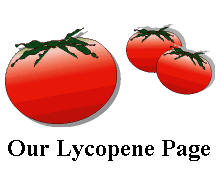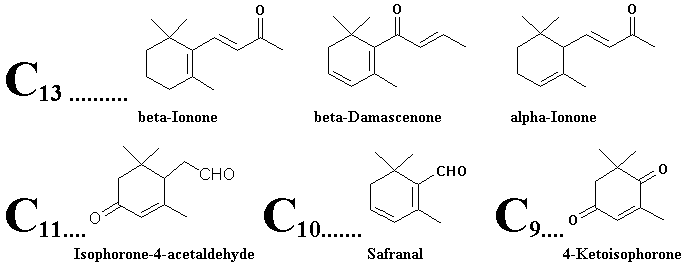|
Leffingwell &
Associates
|
Alchemist WebPick Awarded by the webzine of ChemWeb.com  |
A Review by John C. Leffingwell. Ph.D.
This is the introduction to our series on aroma materials produced by carotenoid degradation.
|
Leffingwell &
Associates
|
Alchemist WebPick Awarded by the webzine of ChemWeb.com  |
A Review by John C. Leffingwell. Ph.D.
This is the introduction to our series on aroma materials produced by carotenoid degradation.
Carotenoids are the pigments responsible for the colors of many plants, fruits and flowers. They serve as Light Harvesting Complexes (with proteins) in photosynthesis. Carotenoids are important in human nutrition as a source of Vitamin A (e.g., from beta-carotene) and as a prevention agent for cancer and heart disease (e.g. lycopene). In addition, carotenoids add color to foods and beverages (e.g. orange juice). And in addition, carotenoids are the precursors of many important chemicals responsible for the flavor of foods and the fragrance of flowers.
Carotenoids are a class of hydrocarbons (carotenes) and their oxygenated derivatives (xanthophylls). About 600 carotenoids have been isolated from natural sources.
Where are Carotenoids Found in Nature
For us, the most important source for carotenoids are plants, where often the brilliant colors of the carotenoids are masked by the green chlorophyllic pigments (i.e. in green vegetables and leaves). In a number of cases, as plants mature, the chlorophyll content decreases leaving the carotenoids responsible for the beautiful colors of most fruits (pineapple, oranges, lemons, grapefruit, strawberry, tomatoes, paprika, rose hips) and many flowers (Eschscholtzia, Narcissus). Carotenoids are also responsible for the colors of some birds (flamingo, canary), certain insects, and marine animals (shrimp, lobster and salmon).
Health Aspects of Carotenoids
Carotenoids are important factors in human health and essential for vision. The role of beta-carotene and other carotenoids as the main dietary source of vitamin A has been known for the better part of this centuary. More recently, protective effects of carotenoids against serious disorders such as cancer, heart disease and degenerative eye disease have been recognized, and have stimulated intensive resarch into the role of carotenoids as antioxidants and as regulators of the immune response system.
Lycopene, a carotenoid found in tomato products, prevents oxidation of low density lipoprotein (LDL) cholesterol and reduces the risk of developing atherosclerosis and coronary heart disease according to a recent study published in the October 1998 issue of Lipids (Agarwal, S., and Rao A.V.; Tomato lycopene and low-density lipoprotein oxidation: a human dietary intervention study. Lipids, 33, 981-984 (1998). This study showed that daily consumption of tomato products providing at least 40 mg of lycopene was enough to substantially reduce low density lipoprotein (LDL) oxidation. High LDL oxidation is associated with increased risk of atherosclerosis and coronary heart disease. This lycopene level can be achieved by drinking just two glasses of tomato juice a day. Research shows that lycopene in tomatoes can be absorbed more efficiently by the body if processed into tomato juice, sauce, paste and ketchup. The bound chemical form of lycopene found in tomatoes is converted by the temperature changes involved in processing to make it more easily absorbed by the body. Ongoing research suggests that lycopene can reduce the risk of prostate cancer and cancers of the lung, bladder, cervix and skin.
For additional information on Lycopene click the image below to go to this web site.

To learn more about carotenoids in Light Harvesting Complexes.....Go LHC
To learn more about natures way of transforming carotenoids into flavor and fragrance materials...continue on.
What do Tea, Rose, Osmanthus flowers, Tobacco, Grapes and Saffron all have in common?
The answer: flavor & aroma constituents derived from carotenoids!
In the discussion of chemical constituents derived from carotenoids in the linked pages we will explore some of the important materials which contribute to the flavor/aroma.
As plants mature, or die, the chlorophyllic pigments rapidly decrease and virtually disappear (one of the normal catabolic changes during plant senescence). [See graphical representation for chlorophyll and carotenoids on senescense ]
The yellow - orange carotenoid pigments of plants also decrease during the senescence or the death phase of plants, but do not always decrease to the point of near extinction as do the chlorophyllic pigments. Thus for plant parts such as the stigma of saffron an intense yellow color (due to carotenoids) remains...and in the green citrus "orange", the fruit turns yellow-orange with maturity.
Below you will see four (of the more than 600) common carotenoid structures found in plants and flowers.


VIOLAXANTHIN

LUTEIN

NEOXANTHIN
The primary odor constituents derived from carotenoids are C13 - C11 - C10 - and C9 derivatives formed via enzymatic oxidation and photo-oxidation of the various carotenoids found in plants, flowers and fruits. While other aroma constituents such as esters, terpenes, pyrazines, etc. are usually also present, these C9 to C13 compounds often are essential to the odor profile. Above you will see a common oxidative fragmentation pattern (shown for beta-Carotene).
Examples of aroma compounds produced in nature are shown below:

|
|
|
|
|
beta-Ionone |
 |
|
|
alpha-Ionone |
 |
|
|
beta-Damascone |
 |
|
|
beta-Damascenone |
 |
Apricot, Rose, Beer, Carambola, Grape, Kiwi, Mango, Tomato, Wine, Rum, Raspberries, Passion fruit, Blackberries |
|
Oxo-Edulan I |
 |
|
|
Oxo-Edulan II |
 |
|
|
Theaspirone |
 |
|
|
4-Oxo-beta-ionone |
 |
|
|
3-Oxo-alpha-Ionone |
 |
|
|
Dihydroactinodiolide |
 |
|
|
4-Oxoisophorone |
 |
|
|
Safranal |
 |
|
|
beta-Cyclocitral |
 |
|
The following links (still under construction) will provide more information on the important carotenoid derived aroma/flavor constituents found in Boronia, Osmanthus, Rose, Tobacco, Saffron, Quince, Tea and more in the future.
leffingwell@mindspring.com
Copyright © Leffingwell &
Associates
TERMS OF SERVICE.............PRIVACY POLICY